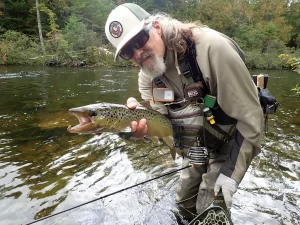Fall fishing offers a unique experience, but changing environmental conditions are shifting the traditional season timeline. In recent years, warmer water temperatures have significantly affected fish activity, delaying their usual patterns. As conditions evolve, extending the fall fishing season emerges as a practical solution to maximize opportunities for anglers.
The Shift in Seasonal Patterns
In regions like the Moosehead and Chesuncook lake areas, late September historically marked the peak of fall fishing. However, recent trends show that by the time optimal fishing conditions arrive, the season is nearly over. Observations from experienced anglers highlight this shift. Rivers and streams remain unusually warm well into the fall, impacting fish behavior and delaying their movement into inshore waters.
For example, recent trips to the Roach River revealed water temperatures as high as 65 degrees in late September—conditions more typical of midsummer. Similar findings were noted on the West Branch Penobscot River and the Kennebec River, where water temperatures remained consistently warm. This warmth affects fish migration patterns, with species like brook trout and landlocked salmon delaying their movement upstream.

Impact on Fish Populations
The delayed spawning runs significantly affect fishing quality. Historically, brook trout and salmon would move from lakes into rivers and streams by early September. This predictable pattern made for excellent fishing. Now, with warmer temperatures, the fish remain in deeper, cooler lake waters for longer periods. By the time they enter the rivers, the official fishing season is nearly over.
Reports from local anglers suggest a notable decline in fish caught during the traditional season. On the Roach River, despite multiple outings, catches were sparse. Salmon far outnumbered brook trout, which were oddly scarce. Even experienced anglers reported fewer fish and less activity overall. Similar stories are emerging across northern waters, indicating a broader trend rather than isolated incidents.
Adjusting to New Realities
Extending the fall fishing season aligns with these shifting conditions. Fish populations are adjusting their spawning schedules in response to warmer water temperatures. By extending the season, anglers can take advantage of this new timeline without harming fish populations. In fact, fishing during this extended period might relieve pressure during the peak of summer, when fish are more stressed due to high temperatures.
Regulatory bodies have shown flexibility in the past. For instance, bird hunting seasons were extended during the COVID-19 pandemic, and open water fishing adjustments have been made due to poor ice conditions. Applying the same logic to fall fishing would ensure that regulations reflect current environmental realities, offering anglers more opportunities while maintaining healthy fish populations.
The Benefits of an Extended Season
- Better Fishing Conditions: Cooler temperatures in late fall create ideal conditions for both fish and anglers. Extending the season would allow access to more active fish, improving catch rates and overall satisfaction.
- Economic Impact: Extended fishing seasons could boost local economies, particularly in rural areas dependent on outdoor recreation. More fishing days mean increased demand for gear, lodging, and guiding services.
- Reduced Pressure on Summer Fishing: With an extended fall season, some fishing pressure could shift away from the summer months. This would benefit fish populations that are already stressed by warm water and high angler activity.
Addressing Concerns
Some might worry that extended fishing could impact spawning fish. However, data suggest that fish are spawning later, aligning with the proposed extended season. Proper regulations, such as catch-and-release policies for certain species, could mitigate potential impacts. Fisheries management teams could monitor these changes to ensure sustainable practices.
The reality of fall fishing is changing. Warmer water temperatures are delaying fish movements, reducing the effectiveness of the traditional season. Extending the fall fishing season would reflect these new patterns, offering better opportunities for anglers while supporting local economies. With proper management, this extension could become a win-win solution, ensuring that fall fishing remains a cherished activity for generations to come. As the saying goes, October has indeed become the new September. Adjusting to this reality will keep fishing both productive and sustainable.
Image/Source: bangordailynews





